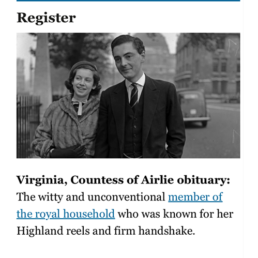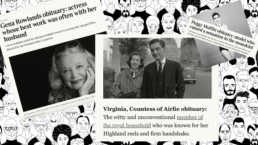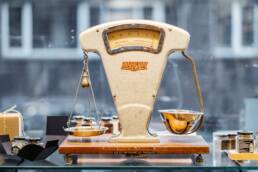An obituary about the late Countess of Airlie, which headlined on her talents of “Highland reels and firm handshake,” sparked a moment of disbelief and then reflection.
Not knowing anything about her, was this really what she would be remembered for, across all her 91 years? If she was worthy of an obituary, what remarkable things had she done – beyond being light footed and heavy handed? After reflecting briefly on mortality, it brought to mind a statistic about how few women receive obituaries, and the tendency towards ‘feminine talents’ covered in those profiles.
Sexism lives on in the afterlife
Because it turns out that sexism is alive and well in the afterlife. Research, both in the UK and internationally, shows longstanding gendered and racial biases in news obituaries. Far fewer women are covered and when they are profiled it often tends to focus on their nurturing or supporting roles, not their individual achievements.
It also found that women were far less likely to have a picture with their obit, but if they did, it was far more likely to be an old picture – that is a picture from a long time ago – than one showing them as they were when they aged. This discrepancy was significantly greater for women than for men. Yes, it’s to be expected when it involves a celebrity renowned for their looks, whether male or female, like French superstar Alain Delon who died recently and was pictured in his glorious heyday. But beyond that, showing only images of younger women reinforces stereotypes about women’s value being associated with their youth, and typifies the news focus on younger, attractive women.

For Virginia, Countess of Airlie, this meant a picture of her aged 19 when she married in 1952, and an account of her role as a mother and a supporter to her husband, and as lady in waiting to the late Queen.
Searching back through The Times for the same week, there were just two other women profiled alongside Virginia, compared to 24 men. And the other two women? Well, the headline for one read: “Gena Rowlands obituary: actress whose best work was often with her husband” and the other: “Peggy Moffitt obituary: model who caused a sensation in the monokini”. And yes, we see Peggy in her monokini with her breasts out, and Gena’s obit is mostly about her husband…

Will you count?
So will you warrant an obituary? Australian academic and journalist Nigel Starck identified six categories as typical grounds for inclusion: fame, association with fame, single acts of notoriety, heroism, villainy, and eccentricity. He also noted: ‘it helps to be male’. In his research, and that of many others, he also found that men typically have greater space devoted to their life stories, and are more likely to be discussed in terms of their individual careers and achievements rather than their link to someone else’s celebrity.
Men are also more likely to gain a slot than a woman, even when their merits are ‘questionable’. One researcher found many men who had a single moment of fame decades before, such as actors or athletes, were still more likely to be included than a woman with an entire lifetime of notable achievements. And that was even more likely where the achievements arose from women-related social purpose such as birth control, saying: “When women’s work primarily impacts women’s lives as opposed to men, their lives seem to be considered particularly insignificant”.
Building a library
Raising the profile of women and their successes during their lifetimes seems a good starting point to tackle this bias, which should help feed into a better library to draw on when they do pass on. That’s one of the aims with the storytelling platform we are developing for This is LUMIN on our website.
Raising the profile of women and their successes during their lifetimes seems a good starting point to tackle this bias, which should help feed into a better library to draw on when they do pass on. That’s one of the aims with the storytelling platform we are developing for This is LUMIN on our website. As well as this digital library, we’re building a human library, so women tell their stories directly through mentoring and knowledge sharing. The aim is simple – to support and encourage, share knowledge and connections, and contribute towards a world of work that works better for women in future.
As well as this digital library, we’re building a human library, to encourage and enable women to tell their stories directly through mentoring and knowledge sharing. The aim is simple: to support and encourage, to share knowledge and connections, and contribute towards a world of work that works better for women in future.
So do share any suggestions for women you would like to see profiled – they don’t have to be celebs or FTSE ceo’s: great work is to be celebrated however high your profile. Send your ideas using this form
And meantime, how about you? What would you like to be remembered for? Share your ideas – even write your own obit – and we’ll feature you on This is Lumin news pages.
Author

This is LUMIN
Editorial from our writers and contributors towards our common goal: raising awareness of the issues that matter to women who want to drive greater success for all, in the world of work and in business
Related Posts
rethinking success: women, business & purpose
Can women lead the way in redefining business success? Not just as participants…
07/03/2025business,mission,entrepreneursBusiness for good,RSA,Professor SIr John Kay,Royal Society for the Arts,women in business,Purpose driven,redefining success
the work-life balancing illusion
We talk a lot about work-life balance, but for many women, the ‘life’ side of…
07/03/2025life,wellbeing,careerssolopreneurship,gender equity,domestic load,productivity,sustainability,multitasking myth,women entrepreneurs,work-life balance,burnout
tackling the march of macho leadership
The march of macho leadership seems unstoppable. How can we foster genuine…
26/02/2025mission,careersElon Musk,Signalling Authenticity,dictatorships,leadership,women in leadership,Vladimir Putin,Donald Trump



